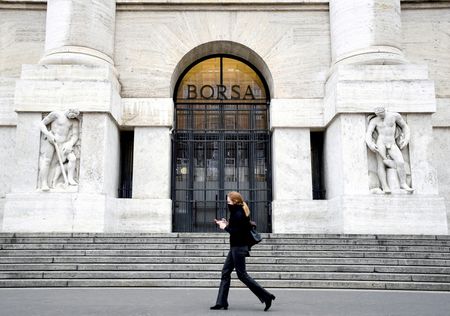By Harry Robertson
LONDON (Reuters) – Italian bonds face a rockier road in the coming months after a period of unusual calm, starting with credit ratings decisions over the next two weeks.
Ratings agency Fitch will pronounce on Italy’s creditworthiness on Friday. Moody’s will follow suit on May 19, and there is a small risk it could downgrade the country to “junk” status.
Such a downgrade – although not expected by investors – could cause bondholders to demand a higher premium on Italian debt.
A spike in Italian borrowing costs could also sow economic and political instability in the euro zone, with Italy possessing one of the biggest debt piles in the bloc. When Italian yields shot up last year, the ECB rushed to create a back-up bond purchase scheme to reassure investors.
A number of other risks have also gathered on the horizon.
There are some signs of discord between Italy and the EU over post-COVID recovery funding; the European Central Bank is withdrawing from the bond market; and Italian banks need to pay back ultra-cheap ECB loans.
Many investors see the Italy-Germany bond yield spread – a closely watched gauge of investor confidence in Italy – picking up slightly in the coming weeks and months.
The 10-year spread has been remarkably low and stable since Giorgia Meloni’s right-wing government took power in October, but it jumped to a one-month high of 198 basis points after the ECB decision’s last week to accelerate its exit from the bond market.
Italy-Germany spread, https://fingfx.thomsonreuters.com/gfx/mkt/gkvlwkrympb/Screenshot%202023-05-10%20083300.png
“We don’t expect a downgrade, but it’s certainly a close call,” said Michael Weidner, head of European fixed income at Lazard Asset Management.
Weidner said he expects the spread to rise above 200 bps. That is still far from crisis levels and well below the 250 bp gap seen last year, but well above January’s low of around 160 bps.
“We’re not too bullish on Italy,” he said. “The spread is a bit too tight.”
RATINGS DECISIONS LOOM
Italy is the euro zone’s third largest economy, behind France and Germany. It is currently the only country on which Moody’s has a Baa3 rating – one notch above junk – and a negative outlook.
In a research note in April, Moody’s analysts wrote that “sluggish growth and higher funding costs may further weaken Italy’s fiscal position”.
Italy’s government debt stood at 144% of gross domestic product at the end of 2022, the second highest ratio in the euro zone after Greece.
A downgrade into junk territory also increases the risk that Italy could be evicted from index funds followed by major investors.
Italy debt, https://fingfx.thomsonreuters.com/gfx/mkt/jnpwyrqoapw/Screenshot%202023-05-10%20082941.png
However, S&P Global Ratings last month kept its rating unchanged at BBB and said the outlook was stable. It said Italy’s debt levels should fall over the next three years.
“I’m more concerned about broader political implications over the summer,” said Lazard’s Weidner.
THE EU AND THE ECB
The European Commission in late March froze an overdue 19-billion euro tranche of post-COVID support funds for Italy. It requested clarification of Rome’s efforts to meet the “targets and milestones” needed to unlock the money.
“Italy really needs this money to advance the structural reforms,” said Laureline Renaud-Chatelain, fixed income strategist at Pictet Wealth Management.
She said she also expects the Italy-Germany spread to rise above 200 bps.
Quantitative tightening (QT) – whereby central banks unwind their crisis-era bond-buying – is another concern.
ECB bond purchases have been particularly helpful for the euro zone’s bigger debtors, but the ECB last week said it will accelerate the pace of QT.
“There are a multitude of risk factors,” said Michael Krautzberger, head of EMEA fixed income at BlackRock. “We are generally conservative.”
Also on investors’ radar is the need for European banks to pay back ultra-cheap loans – known as TLTROs – to the ECB.
Adam Kurpiel, head of rates strategy at Societe Generale, estimates that Italian banks could need to pay back around 180 billion euros ($198 billion) or more in mid-June.
They are likely to have to sell some Italian bonds and tap into short-term money markets to come up with some of the cash, Kurpiel said, potentially adding to the pressure on the country’s debt. He recommends investors bet against Italian short-dated bonds.
($1 = 0.9084 euros)
(Reporting by Harry Robertson; Editing by Toby Chopra)





